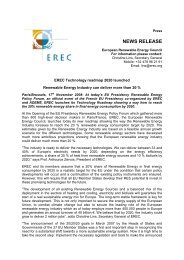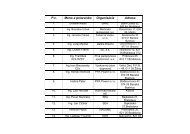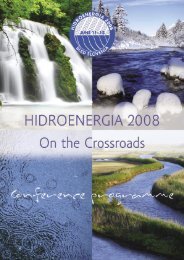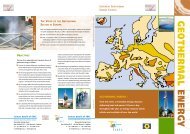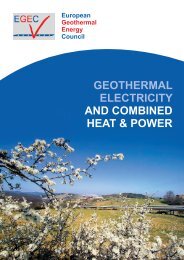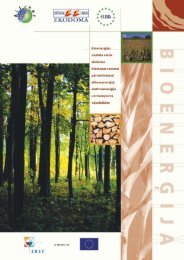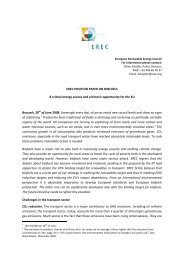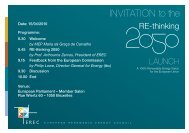CTO Assessment - European Commission
CTO Assessment - European Commission
CTO Assessment - European Commission
You also want an ePaper? Increase the reach of your titles
YUMPU automatically turns print PDFs into web optimized ePapers that Google loves.
ISLE OF WIGHT<br />
Powering the island<br />
through renewable energy<br />
Contact: Jim Fawcett • Renewable Energy Strategy for the Isle of Wight to 2010<br />
Principal Policy Officer • CPCU • County Hall • Newport • Isle of Wight<br />
PO30 1UD • U. K. • Tel/Fax +44 1983 823646/535 • E-mail: jim.fawcett@iow.gov.org<br />
The project brief was to prepare a renewable<br />
energy strategy for the Isle of Wight as part<br />
of a larger project called IRESSI (Integrated<br />
Renewable Energy Systems for Small Islands).<br />
The study outlines the RES exploitation<br />
potential of the Isle of Wight, taking<br />
into account a wide range of factors including<br />
economic, technical and social considerations.<br />
The UK government set a target<br />
for the Isle of Wight to reach 67MW of<br />
energy coming from renewables by 2010<br />
and this project was the subsequent reaction.<br />
The Project<br />
Background analysis : discussing the options<br />
for the Isle of Wight in terms of RES potential<br />
and giving the technical potential for various<br />
options. States possible upper and lower<br />
bounds for the contribution renewable energy<br />
could make to the Island by 2010.<br />
Cost Benefit Analysis: gives the indicative<br />
economic costs in detail and discusses the<br />
environmental and social issues concerned<br />
with each technology option.<br />
Flagship projects: identification of six projects<br />
covering a range of technologies with greatest<br />
potential for short-term implementation.<br />
Overall evaluation<br />
The active participation of the community<br />
was sought as a fundamental first step. Public<br />
opinion is now in favour of trying to achieve<br />
more than the ambitious target of 10% of<br />
electricity generation supplied by RES by<br />
2010 and making greater efforts to conserve<br />
energy.<br />
As a result of the project here is now a greater<br />
technical knowledge; an awareness of the<br />
potential of each technology; what the Island<br />
can support in terms of generating capacity<br />
and how to maximise local gain. On the other<br />
hand, the project was unable to overcome<br />
some local opposition to wind energy (mostly<br />
onshore) as it is believed that it will spoil the<br />
unique environment and landscape of the island.<br />
Enabling factors<br />
The Isle of Wight Council along with various<br />
voluntary and community organisations participated<br />
in public awareness campaigns. ITC<br />
(Intermediate Technology Consultants) produced<br />
technical and cost benefit analysis for<br />
the study. The EC ALTENER programme<br />
provided 50% of the funding. Gotland Energy<br />
Agency became project partners and<br />
acted in an advisory capacity.<br />
Challenges<br />
The study shows that the provisional targets<br />
for local generation could be reached<br />
although the necessary action has not yet<br />
been taken.<br />
Similarly, job opportunities and R&D have<br />
not yet occurred, but the study has raised<br />
awareness of the opportunities.<br />
There was difficulty in analyzing the domestic<br />
use of solid fuels and heating oil for the<br />
baseline data. There would also be difficulty<br />
in being entirely accurate about the renewable<br />
energy potential although this was overcome<br />
by stating upper and lower bounds.<br />
Replication Potential<br />
Similar analysis was undertaken on three<br />
other UK islands at the same time. The same<br />
methodology could be used anywhere but it<br />
would be more difficult to map energy flows<br />
in non-Island areas.<br />
Change in perception of implementing<br />
RES projects (1999 – 2003)<br />
Planning obstacles to RES projects are decreasing<br />
and there is likely to be a more positive<br />
role for local authorities in promoting<br />
RE.<br />
More funding (grant-aid) is available and<br />
greater public awareness of the need for<br />
local generation.<br />
The local population is more prepared to<br />
work alongside the local authority to find<br />
appropriate solutions for the local area.<br />
The Anti-wind lobby is, on the other hand,<br />
becoming more organized and more vocal.<br />
Type of energy Practical Resource % Achievable Contribution<br />
Wind<br />
On-shore wind<br />
Off-shore wind<br />
Biomass<br />
Anaerobic digestion using Dairy<br />
cow<br />
Centralised CHP plant<br />
using 2.8 MW SRC and forest resi<br />
Tidal Currents<br />
Existing RDF/CHP Plant<br />
PV<br />
Lower Bound Upper bound Lower Bound Upper bound<br />
12.0 MW 18.0 MW 5.1% 7.7%<br />
0.0 MW 50.0 MW 0.0% 27.2%<br />
0.2 MW 0.5 MW 0.3% 0.7%<br />
2.8 MW 5.3 MW 3.6% 6.7%<br />
0.0 MW 3.0 MW 0.0% 1.6%<br />
1.7 MW 1.7 MW 1.1% 1.1%<br />
0.0 MW 0.1 MW 0.0% 0.02%<br />
<strong>CTO</strong> - Showcase<br />
79



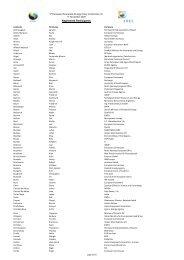
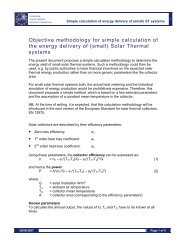
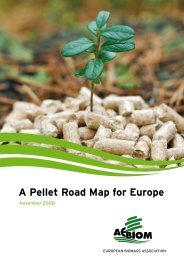
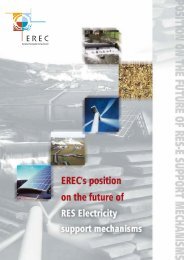

![Energy [R]evolution - Greenpeace](https://img.yumpu.com/47174859/1/184x260/energy-revolution-greenpeace.jpg?quality=85)
